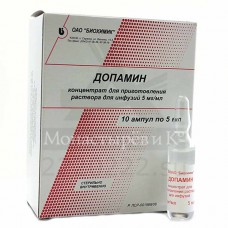Expiration date: 07/2026
Release form
Concentrate for preparation of infusion solution.
Packaging
10 PCs
Pharmacological action
DOPAMINE is the metabolic precursor to norepinephrine (noradrenaline) and epinephrine (adrenaline). Has a specific stimulating effect on dopamine receptors, and at high doses stimulates the ? - and ?-adrenergic receptors. Under the influence of dopamine increases peripheral vascular resistance and systolic blood pressure, increases heart rate, increases cardiac output. Heart rate varies slightly, increases the need for myocardial oxygen, but because of the increase in coronary blood flow is more significant oxygen delivery. Application of dopamine increases the blood flow in the vessels of the heart, brain, Kish of chnica and kidneys, and glomerular filtration and excretion of sodium by the kidneys.
The action of dopamine comes quickly and ends after 5-10 min after the on/in infusion. The half-life of about 2 min. Approximately 50% of dopamine is associated with blood plasma proteins. Dopamine is rapidly metabolized in the liver, kidney and blood plasma under the action of MAO and catechol-O-methyltransferase to inactive metabolites and rapidly excreted by the kidney, mi. About 25% of the administered dose is metabolized to norepinephrine in adrenergic nerve endings. In view of the rapid elimination of dopamine does not accumulate in the body even after prolonged infusion.
Testimony
Cardiogenic, traumatic, postoperative, endotoksicski, hypovolemic shock, acute cardiac and vascular insufficiency, syndrome of low cardiac output.
Contraindications
Pheochromocytoma, arrhythmias, angle-closure glaucoma, prostate hypertrophy.
Method of application and doses
Give/in the drip. 25 or 200 mg. respectively, in the sequence 125, or 400 ml of 5% glucose or isotonic p-RA sodium chloride to 1 ml R-RA contained respectively 200 and 500 mcg of dopamine. With contraindications to the introduction of a large volume the amount of liquid, using more concentrated p-ry, throwing 200 mg in 250 ml of the above R-ROV (1 ml contains 800 mcg of dopamine). The initial infusion rate with an average body weight of 70 kg is 1-4 mg/kg in 1 min (from 2 to 11 drops of 0.05% p-RA or 1.5–6 drops of 0.08% R-RA). The therapeutic dose of 5-9 mg/ kg in 1 min. At vasodilation and arterial hypotension, dopamine should be used in to see 10-15 µg/ kg in 1 min, If necessary, the infusion rate increased to 18 mcg/kg in 1 min. Infusion is carried out continuously for 2-3 hours to 1-4 days. Daily dose is 400-800 mg. Introduction carried out under the control of ECG. The dose and rate of administration is determined by the level of blood pressure, heart rate, heart rhythm, the value of cardiac output and diuresis. Reducing diureza without arterial hypotension suggests the need for dose reduction.
Drug interactions
Dopamine can be combined with cardiac glycosides and diuretics (furosemide, etc.). When hypovolemic shock, the introduction of dopamine combined with the introduction of plasma, plasma substitutes or whole blood.
Should not be administered concurrently with MAO inhibitors, halogenated cyclopropane and means to narcosis (ftorotan, etc.).
R-ry dopamine cannot be mixed with alkaline R-Rami other drugs.



